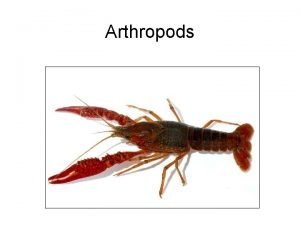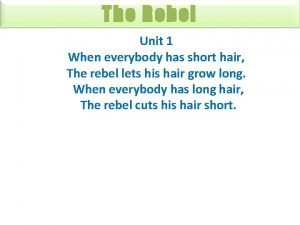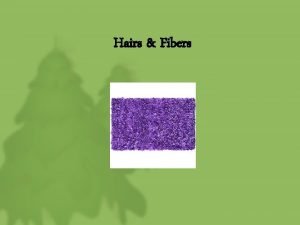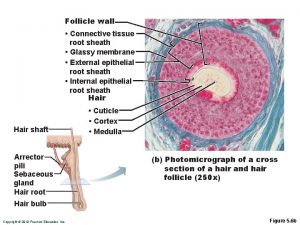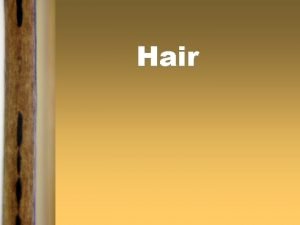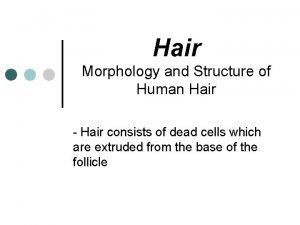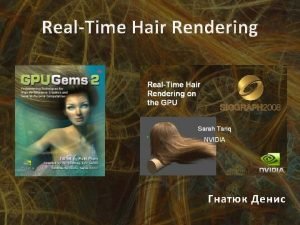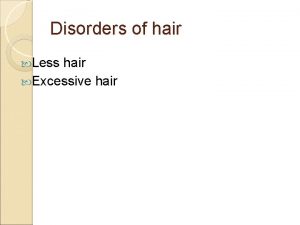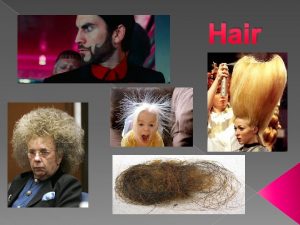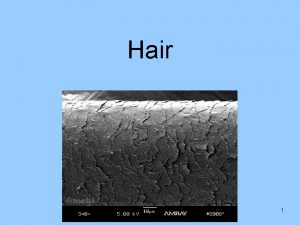Hair Analysis What is Hair Hair Appendage of

























- Slides: 25

Hair Analysis

What is Hair?

Hair= • Appendage of skin • Grows out of a hair follicle • Root, Shaft and Tip

Layers of Shaft Medulla Cortex Cuticle


Cuticle Layer • Tough and Resistant Outer Layer • Overlapping scales made of keratin • Used for species identification


Casting to see scale pattern

Cortex Region • Beneath Cuticle • Contains pigment granules that give color to hair • Look at color, shape and distribution of granules


Medulla Region • Center Region of Hair • Presence and pattern varies from person to person and from hair to hair on an individual Uniserial Multiserial Vacuolated Lattice Fragmented Intermittent Continuous Amorphous

Medulla • Human hairs generally have Fragmented or Absent medulla • Exception: Mongoloid/Asian - usually have continuous medulla


Roots • Necessary for growth of hair • Can tell the growth stage of hair: – Anagen= Actively growing, root is flame shaped – Catagen= Slowed growth, root elongated and shrunken – Telogen= Hair growth ends, root club-shaped, hair falls out of follicle

Roots Follicular Tissue Catagen Anagen Telogen

Hair: Comparative Studies • • • Need comparative microscope Need multiple hairs for comparison Look at overall color, length and diameter Medulla absent or present? Distribution, shape, color intensity of pigment granules in cortex

Hair: Comparative Studies • • Dyed Hair (Paint Roller)vs Natural? Bleached Hair (Yellowish tint) Time of Dyeing? (Hair grows 1 cm/month) Nits or fungal infections?

Hair: Comparative Studies • Types: – Scalp= uniform diameter and pigment distribution – Pubic= short, curly and diameter variations – Facial=Coarse, triangular, blunt tips

Hair: Comparative Studies • Race: – Black= Tight curls, dense uneven pigment distribution, flat to oval hair in cross section – Caucasian= Straight or wavy, fine to coarse pigments that are evenly distributed, oval to round hair in cross section

Hair: Comparative Studies • Age and Sex: – Age and Sex Determination= Most No, – Baby Hair short, thin and fine pigment

Hair: Comparative Studies • Forcibly Pulled Hair – See follicular tissue at root • Isolate Nuclear DNA • Telogen hairs not a good source for DNA • Mitochondrial DNA

Hair: Comparative Studies • Drug use/ Poisoning

Hair Collection • Need control samples • Need at least 50 scalp hairs from an individual • Need at least 20 pubic hairs from an individual • Need full length hair

Cut close to scalp, need minimal amount of head and body hair

• http: //www. youtube. com/watch? v=Z 9 L com/watch? v=Bd 170 NWE i 3 MC 4 d-Hm. Y • http: //www. youbea uty. com/hair/videothe-science-of-hair
 Epidiymit
Epidiymit Jointed appendages meaning
Jointed appendages meaning Right atrial appendage
Right atrial appendage Cpt code for left atrial appendage ligation with atriclip
Cpt code for left atrial appendage ligation with atriclip Dark hair and blonde hair parents
Dark hair and blonde hair parents Uses of tacheometric surveying
Uses of tacheometric surveying When everybody wears a uniform the rebel dresses in
When everybody wears a uniform the rebel dresses in Hair grows in diagonal tubes called hair
Hair grows in diagonal tubes called hair Difference between animal and human hair
Difference between animal and human hair Heterozygous tabby x stripeless
Heterozygous tabby x stripeless Root sheath
Root sheath Canities
Canities History of hair analysis
History of hair analysis Heidi with the blue hair
Heidi with the blue hair Hair type
Hair type Horizontal lines in hair
Horizontal lines in hair Keratin definition forensics
Keratin definition forensics The cutting of my long hair analysis
The cutting of my long hair analysis For heidi with blue hair
For heidi with blue hair The most common type of plant fiber is
The most common type of plant fiber is My parents poem
My parents poem Bernice bobs her hair analysis
Bernice bobs her hair analysis Is hair class or individual evidence
Is hair class or individual evidence Disadvantages of structured analysis
Disadvantages of structured analysis Autohotkey obfuscator
Autohotkey obfuscator Discourse analysis vs content analysis
Discourse analysis vs content analysis

